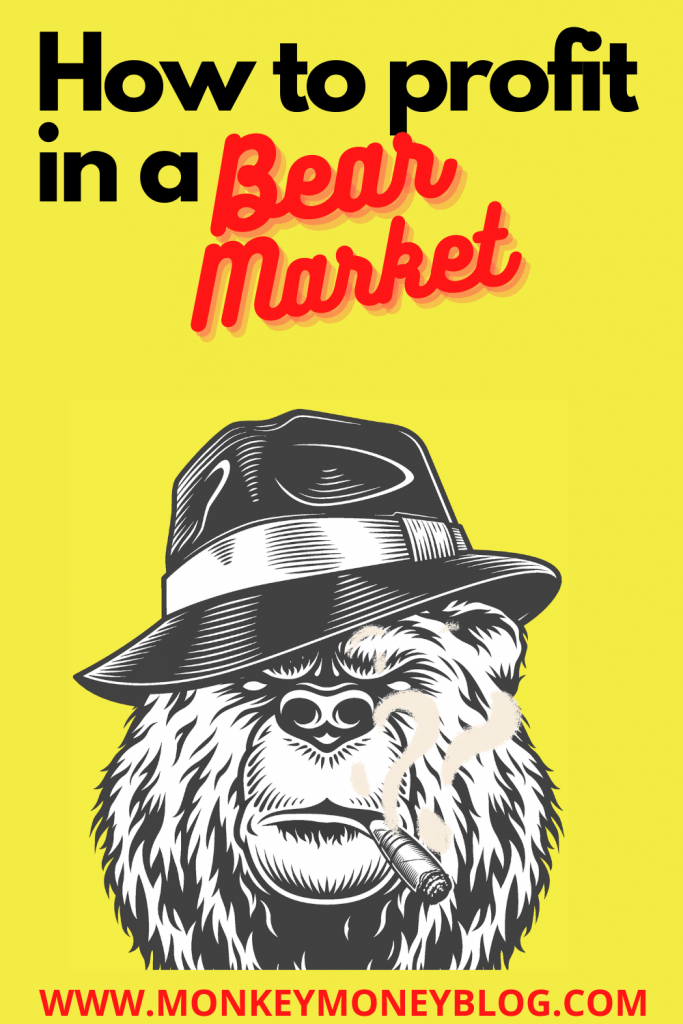So now Russia is invading Ukraine and that has all the markets going crazy as Europeans think this could become a 3rd World war as it is close to their borders.
This is definitely not good for the markets, especially because they have been receiving hits from the beginning of the year, and is about to be declared a bear market.
Not being good for the markets doesn´t mean that it has to be bad for you, as there are various ways to earn money during bear markets, and some are very profitable.
Anyway, bear markets tend to be shorter than bull markets. (If you revise the history of the NYSE, it has an average of 1 bear market year for every 7 bull years)
1. FIND GOOD STOCKS TO BUY
It is known that when a Bear Market comes, most of the stocks follow their lead, but there’s always a little percentage of stocks that don’t follow their lead and perform well.
As a matter of example NYMEX:WTI the Oil Price Futures has been killing it since the beginning of the year.
WTI Futures – May 2022 – MSN Money
There are other stocks that during that downfall period receive the overreaction of their investors and these stocks Get hit more than they should.
2. FIND BAD STOCKS TO SHORT
Nowadays you can find all kinds of products, ETFs, shares, bonds, options that do the opposite than the market do, for example, if you see the Nasdaq Index ETF QQQ, there is a reverse ETF called SQQQ that in January to February has been doing quite well. (+20%).
Here you can find frauds, companies that are overvalued, or sometimes artificially hyped companies that have a short high valuation and then a much faster decrease in their stock prices.
2.1 Company Frauds.
WORKER TAKING DOWN ENRON’S SIGN AFTER THE COLLAPSE.
There is the time when companies lie in their business performance, they thicken the real sales numbers, decrease the real expenses and obligations, disappear debts which makes the stock price higher than it should be.
A remarkable company that used this strategy to inflate its stock price was Enron, which led to one of the biggest and more sound crash and burn in the market history, not only for the size but for the constant lies to the market.
2.2 Artificially Hyped Stocks
Penny stocks, have you heard about them?
Well, not all the penny stocks are artificially hyped stocks, but some of them are and those can increase their value more than 300% in one day.
People like Tim Sykes, or Tim Grittani became famous for recognising and predicate about the earnings they were obtaining from shorting these stocks daily.
So how do you short these stocks?
The logic is simple, find a stock that has increased its value in premarket hours (more than 50%). For this you have to:
- Filter by number of stocks: hopefully stocks with less than 30.000.000 stocks
- Price: the stock price below $10 and above $1
- Volume: more than 200,000 daily.
Well, not all sectors of the economy act the same during a recession or a war.
Everyone that has not invested in petroleum is complaining about the gasoline price because it is in the sky. (Well it might be a good time to short it then).
Seems to be that metals, petroleum, gas and other “materials” are having a wonderful beginning of a year, while the technology is having a rough time.
Well, all of this respond to patterns that repeat over and over again in a business cycle.
These patterns can be recognizable into 4 different phases of sn economy or business :
- Early cycle phase
An early recovery of a recession, marked from a rupture from negative to positive growth in economic activity.
Mid-cycle phase
This is generally the longest phase of the cycle of a business.
It is characterised by a more moderate growth rate, acquiring a balance between all of the different areas of the market or business.
- Late-cycle phase
This is a phase where the economy starts to overheat, causing the growth to stall. Credit might begin to be more restrictive and the margins of the business begin to decrease. Sales decrease and inventories start to accumulate.
- Recession phase
The economy shrinks, profits decline and monetary policies accommodate for a new start.
3. WRITE A PUT OPTION TO GENERATE INCOME
Before starting it is important to define 3 simple terms that will be used in this part of the post: Options, Strike Price and Expiration
– Options: A financial contract that gives the buyer the right to buy or sell 100 shares of stock at the option’s strike price or before expiration.
– Strike Price: The stock price in which an option buyer can purchase or sell 100 shares upon exercising the option.
– Expiration: the date an option ceases to trade on the market, and converts to shares of stock, or expires worthless.
A Put Option, is a strategy to create the opportunity to buy a stock at a discounted price on a certain date, it is used to generate income in two ways, by taking advantage of the fee for having a better price to buy the stock, or using the option to buy stocks at a discounted price.
There are two individuals in this transaction, a Writer that “Writes the Put Option”(in Easy words, the one that has the Idea of having an option of buying these stocks at a lower price and pays for the option) and the Buyer of this Option that “executes the option and buys the stocks at the written price”. (The one that purchases the Option to the writer and buys the stocks at the option price).
3.1 Generating income by taking advantage of the premium for the stock option (Put Writing for Income)
When writing a Put Option, the individual that writes the put option agrees to purchase the stock at the strike price if the contract is exercised; in easy words, you agree on a price to buy a set of stocks in a certain time frame, If the stock is higher than the price you agreed to pay for the stocks you earn money as you have an option to buy these stocks at a lower price.
If the stock price is lower than the price you agreed to buy them, then you lose money, because you are committed to buying the stocks at a higher price than they are today.
Example with three different scenarios:
You win Money: Let’s say you want to deal with ABC Stock price which is $30.
Put options with a strike price of $26 are trading for $3 (every contract is for 100 shares).
A put Writer (The Owner of the Option) could sell this Option for $26 a strike price and collect the $3 fee (known as Premium) for 100 stocks.
- Market Value = $30 x 100 = $3.000
- Price Paid = ($26 x 100) Price Paid + (100 x $3) Premium = $2,900
- Collected = Market Value – Price Paid = $100
Breakeven: This time ABC Stock price has decreased to $29.
Put options with a strike price of $26 are trading for $3 (every contract is for 100 shares).
A put Writer (The Owner of the Option) could sell this Option for $26 a strike price and collect the $3 fee (known as Premium) for 100 stocks.
- Market Value = $26 x 100 = $2,600
- Price Paid = ($26 x 100) Price Paid + (100 x $3) Premium = $2,900
- Collected = Market Value – Price Paid = Breakeven
This time the Market Value is similar to the Price Paid so you break even.
Lose Money: This time ABC Stock price has decreased to $25.
Put options with a strike price of $26 are trading for $3 (every contract is for 100 shares).
A put Writer (The Owner of the Option) could sell this Option for $26 a strike price and collect the $3 fee (known as Premium) for 100 stocks.
- Market Value = $25 x 100 = $2.500
- Price Paid = ($26 x 100) Price Paid + (100 x $3) Premium = $2,900
- Collected = Market Value – Price Paid = – $400
3.2 Take advantage of the Price of the stock for going Long on the Stock. (Writing Puts to Buy Stock Longs)
In this case, you want to take advantage of the discounted stock price to go Long on the stocks, but you can generate income by selling the stock at a higher price than the one you bought the stock.
Instead of using the Premium-selling strategy, in this case, is the writer the one that wants to purchase shares at a lower price than the current market price.
Let’s see it with examples again:
You win Money: let’s assume that ABC is trading at $50, an investor writes a put option at $45
If the stock drops below 45, the option sell would obligate this investor to buy the shares at $45
4. BUY A CALL OPTION
Ok, we know what is to write a Put Option, now let’s review what a Call Option is.
A Call Option is a contract that allows a buyer of this Option to buy a security (stock) at a specific price (strike price).
The difference with the put option is that a put option allows the holder to SELL a security at a specific price.
Both, the Put and the Call options expire at a determined date.
These options are widely used in the market to trade various types of securities including ETFs, bonds, interest rates, futures, indexes, currencies, and swaps.
One thing to have in mind is that an investor who buys a Call Option is not obligated to exercise the option, they could decide not to buy the securities if they don’t want to. Why wouldn’t want to execute the option? Imagine if the price that the stock they have the option is higher than the actual price of the stock, then it wouldn’t make sense to make a trade where you are going to lose money.
This is true unless at the expiry of this option it is in-the-money (ITM), this means that the security’s current market price is higher than the call option Strike price, therefore it will be automatically executed.
5. WRITE A COVERED CALL OPTION
A Covered Call is a way of producing income where you sell (or Write) a Call option against shares of Stock that you own. Typically, you will sell one contract for 100 shares, and in exchange for that transaction, you will collect the premium (the fee).
In this case, you have to take into account that this time it comes with an obligation because if the option you sold is exercised by the buyer, you have to deliver (sell) the stocks to the buyer at the agreed price.
In this case, you have those stocks, that is why is called “Covered”.
Don’t forget that in this case, you have to pay two commissions, one to sell the option and another to sell the stocks
Is there anything you will like to add to this post? Let me know in the comments







Everything is very open with a very clear description of the issues. It was truly informative. Your website is useful. Thanks for sharing!
Thanks!